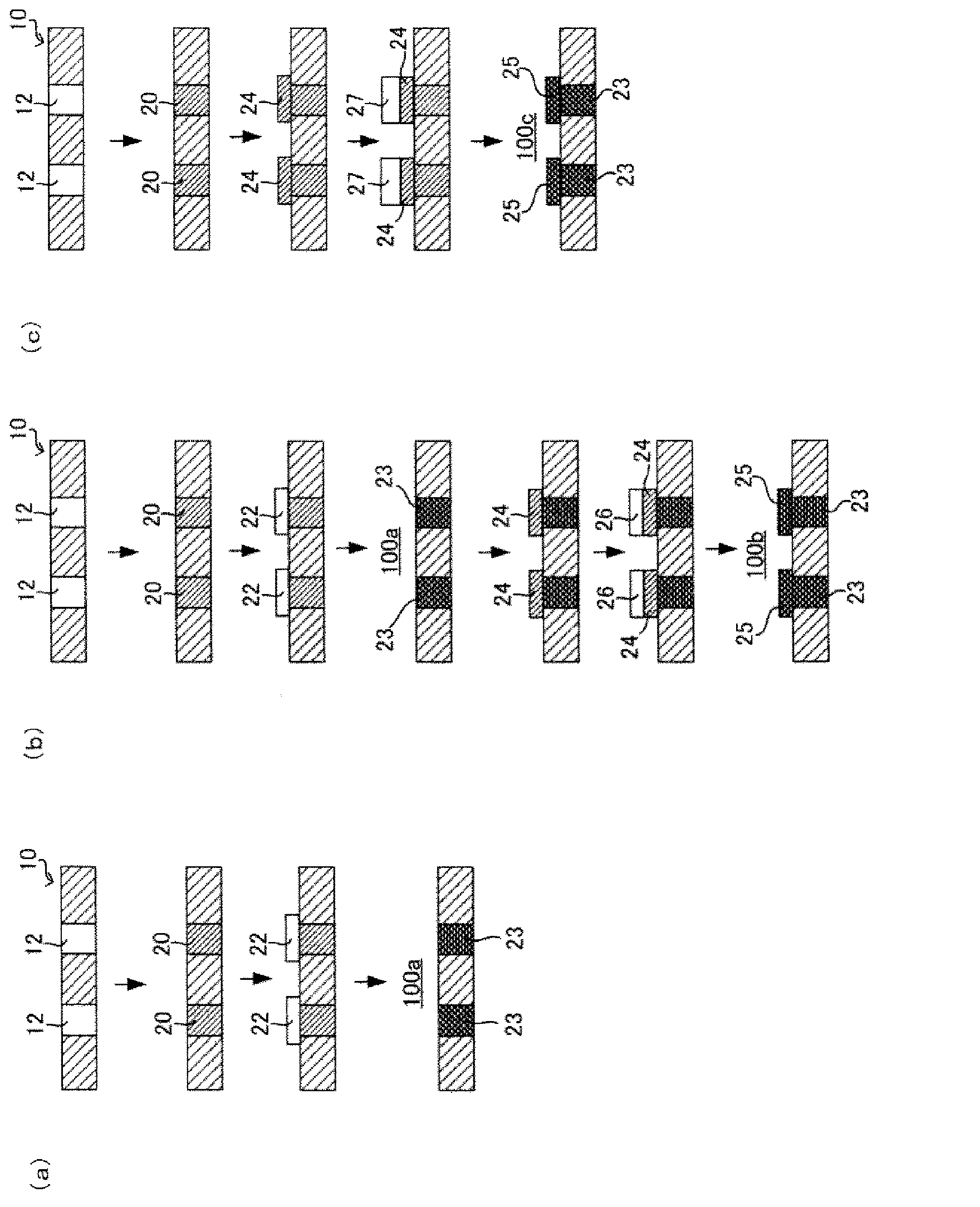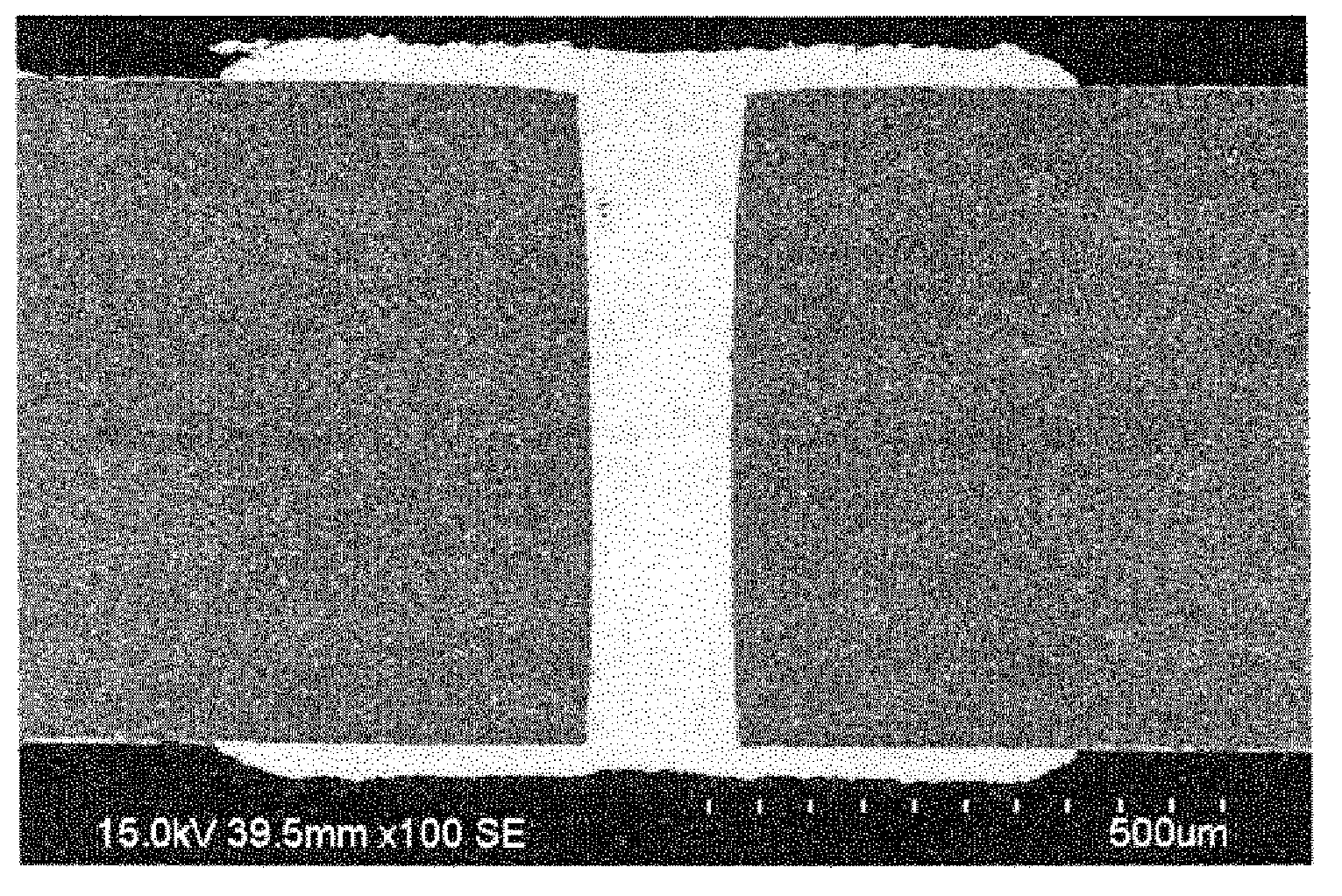Ceramic via substrate, metallized ceramic via substrate, and method for manufacturing both
一种通孔基板、陶瓷的技术,应用在印刷电路制造、金属花纹材料、电气元件等方向,能够解决生产率下降、不是制造金属化通孔基板、难以形成致密的通孔等问题,达到密合性良好的效果
- Summary
- Abstract
- Description
- Claims
- Application Information
AI Technical Summary
Problems solved by technology
Method used
Image
Examples
Embodiment 1
[0168]
[0169] (Production of the first metal paste)
[0170] Using a mortar, 100 parts by mass of copper powder with an average particle diameter (D50) of 5 μm as metal (B) powder, and 3 parts by mass of titanium hydride powder with an average particle diameter (D50) of 5 μm as active metal powder, and terpine An excipient in which polyalkylmethacrylate was dissolved in alcohol was premixed, and then dispersed using a 3-roll kneader to prepare a first metal paste.
[0171] (Production of the second metal paste)
[0172] Ag-Cu alloy powder (BAg-8: melting point 780° C., composition: silver 72 mass %-copper 28 mass %) as metal (A) powder with an average particle diameter (D50) of 6 μm, and terpine An excipient in which polyalkylmethacrylate was dissolved in alcohol was premixed, and then dispersed using a 3-roll kneader to prepare a second metal paste.
[0173] (Manufacturing of ceramic through-hole substrates)
[0174] (Process (i), process (ii))
[0175] An aluminum ni...
Embodiment 2~5
[0182]
[0183] Except that the raw material composition of the paste was set to the composition shown in Table 1, and the firing conditions were set to the conditions shown in Table 2, it was performed in the same manner as in Example 1 to produce a ceramic through-hole substrate 100a and a metal plate for evaluation. The chemical substrates were analyzed and evaluated as described above. The results are shown in Table 2.
Embodiment 6
[0184]
[0185] (Production of the third metal paste)
[0186] As the metal (B) powder, 12 parts by mass of copper powder with an average particle diameter (D50) of 0.3 μm, 59 parts by mass of copper powder with an average particle diameter (D50) of 2 μm, and 29 parts by mass of an average particle diameter (D50) were used 0.6μm silver powder. A total of 100 parts by mass of metal (B) powder, 5 parts by mass of titanium hydride powder having an average particle diameter (D50) of 5 μm as active metal powder, and polyalkylmethacrylate dissolved in terpineol were mixed using a mortar. The excipients were premixed, and then dispersed by using a 3-roll mixer to prepare a third metal paste.
[0187] (Production of the fourth metal paste)
[0188] As the metal (A) powder, 50 parts by mass of Ag—Cu alloy powder (BAg-8, composition: silver 72 mass %-copper 28 mass %) with an average particle diameter (D50) of 6 μm was used. Among them, 50 parts by mass of copper powder having an a...
PUM
| Property | Measurement | Unit |
|---|---|---|
| melting point | aaaaa | aaaaa |
| melting point | aaaaa | aaaaa |
| melting point | aaaaa | aaaaa |
Abstract
Description
Claims
Application Information
 Login to View More
Login to View More - Generate Ideas
- Intellectual Property
- Life Sciences
- Materials
- Tech Scout
- Unparalleled Data Quality
- Higher Quality Content
- 60% Fewer Hallucinations
Browse by: Latest US Patents, China's latest patents, Technical Efficacy Thesaurus, Application Domain, Technology Topic, Popular Technical Reports.
© 2025 PatSnap. All rights reserved.Legal|Privacy policy|Modern Slavery Act Transparency Statement|Sitemap|About US| Contact US: help@patsnap.com



